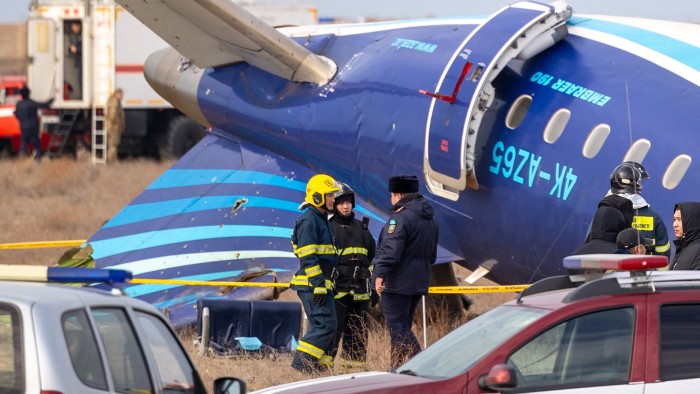Useful information
Prime News delivers timely, accurate news and insights on global events, politics, business, and technology
Useful information
Prime News delivers timely, accurate news and insights on global events, politics, business, and technology

Unlock Editor’s Digest for free
FT editor Roula Khalaf selects her favorite stories in this weekly newsletter.
Russian anti-aircraft fire may have caused a plane to crash in Kazakhstan on Christmas Day, according to US and regional officials.
The Kazakhstan Airlines flight was headed from Baku, the capital of Azerbaijan, to Grozny in Chechnya, southern Russia, when it diverted and crashed in Kazakhstan, killing 38 people. Twenty-nine passengers survived.
Most of the occupants of the plane, an Embraer 190, were Azerbaijani citizens. Also on board were 16 Russians and several citizens of Kazakhstan and Kyrgyzstan.
In preliminary official reports on Wednesday, Russia said dense fog had forced the plane to divert from its planned landing in Grozny and attempt to land in Kazakhstan, where it crashed after likely hitting a flock of birds. On the same day, Azerbaijan’s president said he had been informed that the plane had been diverted due to poor weather conditions.
But that was disputed by experts and officials from the United States, the region and Ukraine, who cited evidence that Russian air defenses were operating over Grozny at the time in response to a Ukrainian drone attack. They also cited images of what appeared to be shrapnel damage to the interior and tail of the mangled plane.
A U.S. official said there were early indications that a Russian anti-aircraft system may have hit the plane. If this were the case, the incident would further underline Moscow’s recklessness since its large-scale invasion of Ukraine, the official added.

Andriy Kovalenko, an official at Ukraine’s National Security and Defense Council, posted on Telegram: “Russia was supposed to close the airspace over Grozny, but it didn’t. . . The plane was damaged by the Russians and sent to Kazakhstan, instead of making an emergency landing in Grozny and saving lives.”
Senior Ukrainian officials confirmed to the Financial Times that kyiv believed the plane was likely hit by Russian air defense systems.
Osprey, an aviation safety agency, said: “Tracking video of the wreckage and the circumstances around the airspace safety environment in southwestern Russia indicate the possibility that the plane was hit by some type of flak”.
A senior official in the Caucasus region said evidence pointed to the plane being damaged by air defenses over the Grozny area.
“If (Russian authorities) are going to use jamming systems and anti-aircraft systems, they should have closed the airspace,” the official told the Financial Times. “The most benign explanation for why they didn’t do it is incompetence.”
If the investigation, led by Kazakh officials, concludes that the plane was hit by air defense systems, the incident would be reminiscent of the downing of Malaysia Airlines flight MH17 in 2014. The crash, which killed 298 people, was caused by a missile launched by Russian-controlled allied fighters in eastern Ukraine, an investigation concluded.
Data from tracking service Flightradar24 shows that the Azerbaijani plane stopped continuously recording its position once it reached the North Caucasus area, suggesting the GPS was jammed.
However, Flightradar24 found that identifying information was available showing that the plane had made it as far as Grozny before changing course towards Kazakhstan.
Images from the crash site show that much of the front of the plane was half destroyed, but a large portion of the tail remained intact. The tail appears to be covered in impact marks and small punctures that could be consistent with an attack by a surface-to-air missile defense system, according to military experts.
“The holes in the fuselage are very similar to the impact of the type of projectiles with which air-to-air missiles are usually equipped, as well as anti-aircraft missiles launched by air defense systems such as Pantsir-S1,” said Ruslan Leviev, military analyst and head of the Conflict Intelligence Team, an open source research group.
Kremlin spokesman Dmitry Peskov said it was premature to speculate on the causes of the accident. Kazakh authorities said it was “unethical” to blame the missile firing before the investigation was concluded.
A National Security Council spokesman said the United States had seen the reports but referred journalists to officials in Azerbaijan and Kazakhstan as the investigation continued.
In a statement, the plane’s manufacturer, Embraer, said it was “deeply saddened by the event.”
“Our thoughts and deepest condolences go out to the families, friends, colleagues and loved ones affected by this incident. “We are closely monitoring the situation and remain fully committed to supporting the relevant authorities,” the company said.
Cartography by Steven Bernard